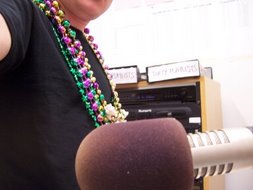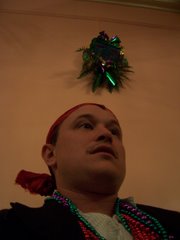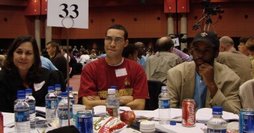
The passing of James Brown triggered tributes from around the world. Crowds circled the Apollo in Harlem, obituaries struggled to cover the breadth of the Godfather’s influence, and fans everywhere remembered the impact his voice made upon first listen. Following the best mourning technique available to me, I dedicated a radio show to the music and tributaries of Soul Brother Number One. From 10pm-midnight on the first Thursday of 2007, I spun JB and JB-related tracks over the airwaves of WTUL 91.5FM in New Orleans. This meant music from Fela Kuti, Eric B. & Rakim, Parliament, Pete Rock, Nas, the Meters, Afrikaa Bambaata, Biz Markie, Madlib, and more, from Nigeria to Los Angeles to Kingston, from the early 1960’s to 2006.
Standing in the station’s makeshift studio in a half-empty shopping center in New Orleans, 2007, I did the leg-kicks and screamed in between setting tracks, struck once again by the sheer force of James Brown. And I thought a lot about what that force made possible—the stilling of riots, the defiance on the White House lawn, the steely confidence and pillar-samples that began hip-hop. At one point I played a Trombone Shorty track and wondered if someone could have that JB-effect on this city. What if the music could politicize or make certain elements coalesce and burst forth, refuse to allow anyone to quit? Aren’t we ripe for it? Finally, I thought about what a bad motherfucker James Brown was to do what he did, from a whorehouse boyhood in the Deep South to a towering genius of the 20th century. I shut the station down a little after midnight and walked out the back door, glad I’d gotten that out of my system.
Last weekend, I went to a James Brown tribute show at Tipitina’s. We paid $20 a ticket with the simple hope that some of the city’s most popular musicians, along with a former JB horn player, would show their respects in the best way possible—playing the hell out of his music. If anyone can channel Mr. Dynamite, we agreed, this crew could.
This was my first time back at Tipitina’s since New Year’s Eve, 1999, the misguided Y2K celebration with the Funky Meters when I got wine all over my one and only white suit. It was also my first time standing in a fairly long line to spend 20 bucks at Tipitina’s, but I swallowed that because I know they need the money and anyway, isn’t it great so many people want to come to this tribute? And besides, I just got paid…
Fast-forward an hour, a few High Life’s, and a seemingly endless instrumental…
After waiting too long and making several attempts to dance the disappointment off, we made our way toward the balcony stairs. I was a little hesitant, actually, because the solos kept improving, but I went. The floor was still packed. As we reached the door, I stopped again and focused on the stage. The JB-horn hit the chorus and began to chant, “Party! Party! (Pause) Party! Party!” Above us, the rectangle balcony rippled with hands clutching drinks, all in time to the chant and chanting themselves, Party! Party! I turned away from the stage to face the upper rear and watched them cheer as if in a happy cloud, the club lights dancing as the band crescendos. I thought, no, no, fuck no. A furiously good-timing applause demographic, a relentless celebration class. Maaaaaan, I thought. Fucking man.
What’s going on?
What’s going on is that there lives in this tippling metropolis a swath of kids for whom shit is ok. Regardless of conditions in town, shit continues to be O fucking K, better believe it. That’s not to say there’s anything new to that. It’s what they’re getting—this monotonous joyride, this simpleton’s baroque—that’s different. And it’s who’s giving it to them.
Much of the upper middle class white college experience is dominated by jam band music. Completely unscientific statement, but I think a lot of you know what I mean. Variations on the Grateful Dead scene are part of almost every university landscape, in every part of the country. This phenomenon became especially big in the mid-to-late 1990’s, as bands like Phish or Dave Matthews gathered these nebulous followings, with bootleg tapes as their runes and hemp bracelets their charms. Well-off boys and girls spent summers traveling to shows, tripping and enjoying the neo-Sixties freedom vibe.
Jam bands became a rite of passage, a phase option. You’d meet kids back then who’d be carrying around a whole suitcase of cassette tapes of different, mutedly recorded concerts. They’d sell them or trade them, just like baseball cards when we were younger. Some of these hippie remix dudes even had snotty attitudes about the knowledge they possessed, like, of course you know 1989 Syracuse, or whatever the fuck.
Anyway, that culture has gone on now for at least 10 years. At this point, you have the second or third wave of listeners to this music, many of whom are unfamiliar with the derivative’s source (the Dead), and completely ignorant of the fact that the Dead actually were just a watered down version of a deeper source (the rest of American music, mostly Rhythm and Blues, though cats always want to act like there’s jazz in there, too, by which they mean Bitches Brew). These people are just high on the long solos and the assurance of knowing a sound and identifying it with a name—Widespread Panic…for instance.
What this translates into: The focus of that swath of kids on a view of music as a slice of lifestyle and as commodity; a specifically weird concept of recorded and live music; and some demand for cheery repetition and nods at the authentic, most often the black. They go on name recognition and a certain arc of satisfaction: Bass Player X =Plays Famous Party Song (@ Legendary Club). Mostly, they want a drunken, perhaps high good time, to meet people to fuck with, and do the whole party thing, same as anywhere. They go and they have a fucking blast.
Which is fine. That happens.
The problem is, that’s the paying public in New Orleans right now. They’re it. That’s who’s driving the attention, the spotlight in the city—a rare pool of music-goers who will go out and spend some money, blow up the liquor tab, and come back for more. These are white kids between 18-30 with $20 to blow. Most of them are sitting pretty and uninterested in challenging that status. I mean, I saw at least three of them wearing tuxedos--no shit--and some more in suits.
This is a cleaner breed of local music fans, interested in what they expect is the sound of fun, with familiar references and displays of ballsy virtuosity. If a player of some fame can be located, or a local favorite sideman, that’s all the better, they’ll up the ante. Funkiness is especially valued, as well as swagger. But they’ll take the whole thing spacey, with long solos and noodling spells that remind them of those breezy days watching the jam bands in a big festival crowd of the like-minded. No need for originality or precision or dynamics—a freaky looking guitar player will do; hell, he can play flute if he wants.
They also like references to New Orleans. They want to know it’s New Orleans Time here, and that means we can fucking Party! Yeah, you right! Whether New Orleans means something more that that to them, I’m still unclear. They like something simple and loud and ‘authentic,’ and I supposed there’s an idealized New Orleans out there that, if you squeeze your eyes tight enough, might be all of those things. The storm, the bullets, the shuttered clubs and bars—there’s really no room for that when you have party fever. They like who they like and they ask very little else.
That’s why it was so hard “seeing” James Brown there: no one even cared. It was enough for everyone to call the thing a James Brown tribute, and once they got inside, they forgot it was even called that. They settled in for some noodling and familiar funk, and all became a reefer-y bliss. There was nothing different at all from any night in the orbit of this crew, just standard jamming.
So why drag James Brown into it? Well, who did that and where did they fuck up?
I’m not mad at Tip’s. I thought it was a good idea, otherwise, why would I’ve shown up? Tip’s put the thing on and I was willing to pay the $20, even wait in a line. Tip’s had the right thought, but they found the wrong guys.
The only people who had some choice in the matter, in terms of not being who we’d expect them to be, were the musicians. They got up there, they played how that crowd wanted them to, and they neglected James Brown. If it had been a straight up funk show, where people burned through their own songs, no JB songs, I’d say, look—that’s a way to pay tribute to the man, by doing your own thing like that. If they’d done a few covers in shabby fashion, I’d still think it was cool of them to try. If they’d played more than one discernible cover of a JB song, I’d probably not miss the cash.
But when the clearest reference to the “man of the night” goes like this-- the JB-horn sings a chorus of “Make It Funky,” and follows in the next chorus with “Take Me Higher”, from the Sly song-- then I’m pissed. Because they could’ve done anything, even gotten away with it in front of this drone dance-a-thon. They could’ve done anything, and they did nothing. They played limp (except for a few guest soloists).
At one point I thought, wow, I’ve seen that guy tuning up in a more spirited way than this. Once I was on the ground floor of the Funky Butt and saw that drummer do a million new things while tonight he refused any. And James Brown was the supposed theme! The heralded rhythm section arrived under the banner of the greatest drum/bass lines created. This is the shit we know they can play, shit that was cut up and replicated and redone all over the musical world, gave birth to this “funk.” But it was almost like they forgot James Brown was there. I guess they knew it didn’t matter, the crowd would roar for their triumph regardless. In that case, why care? Why fuck with that? For whom?
And I’m as bad as anyone else, maybe worse, because I know better. Yes, that’s in hindsight, but I’ve seen more of this sight than ever before. That naked exchange, the replicated, round-corner New Orleans scarfed up by eager pleasure children, it’s allowed to run free here today in places never before reached. Because of sheer numbers, this is what too many musical experiences look like, with a couple of guys standing in the middle of the crowd, one screaming to the other over the roar that “this is what this city’s all about!” But I know this, I dropped $20, and what did I expect?
“Why call it a James Brown tribute show?” I kept saying on the way out of Tipitina’s. And therein lies the root cause of my foolishness, that the bullheaded hope. I thought James Brown made it different. I thought the musicians might channel him, with our collective circumstances serving as a backdrop, the perfect veil to slice up with the Godfather’s razor. But not on that night, not with these musicians. They just showed up and played the function. They didn’t see anything more at stake, James Brown, or not.
But a lot more is at stake. “A culture’s sad finale?” ran the headline in the Chicago Sunday Tribune, coincidentally published the day after the show. With the characteristic bleakness and power-quotes, the article described a desperate city where:
“The musicians who are still there, as well as writers and visual artists, wonder whether they can stick around much longer in the face of surging violent crime and political leadership that severely undervalues the city’s arts.” (2/4/07)
Amidst the usual discussions of the Musicians Village and voodoo, the article warns that the city’s culture may slide into the swamp any day now “unless someone does something soon to bring the exiled artists back….” I have to ask: what happens if the artists who are already here do nothing to stop that slide? What if they let it happen, too busy catering to an audience that will stay dry no matter the weather?
We need James Brown a lot more than we realize.











